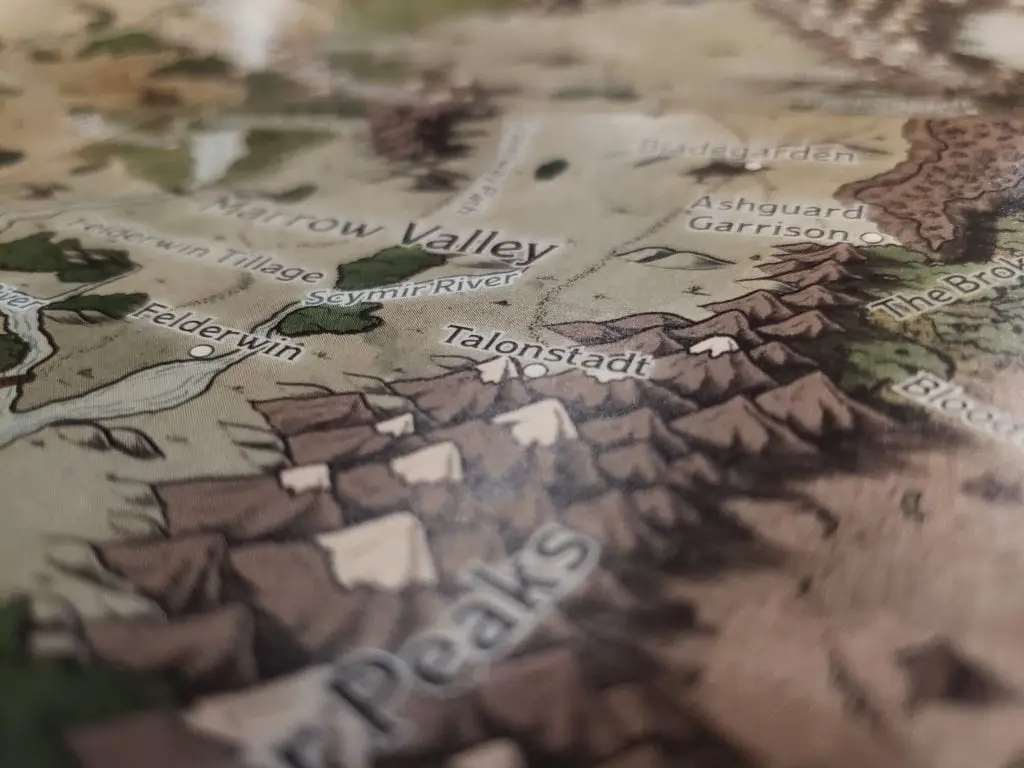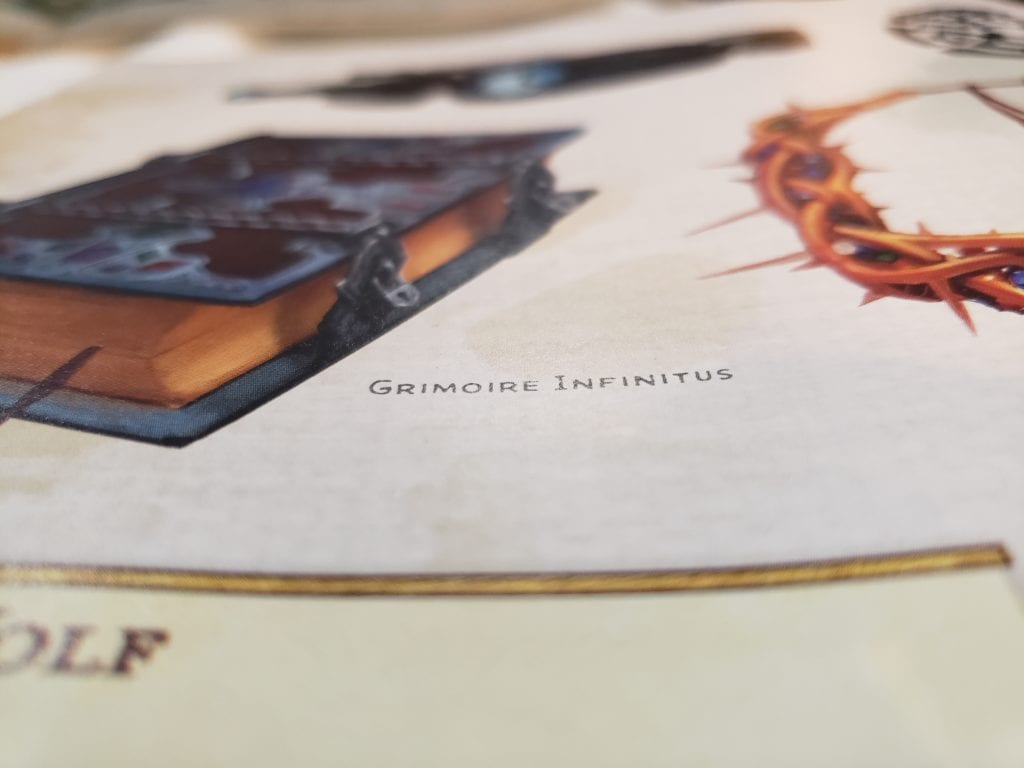When I received the Explorer’s Guide To Wildemount a few days before it’s release, I was a little apprehensive. I love Dungeons & Dragons and am always excited for new content for it, but this one was different from previous releases. Unlike the Guildmaster’s Guide To Ravnica, which adapted a plane from Magic: The Gathering, or Baldur’s Gate: Descent Into Avernus, which was full of easter eggs from the classic video games, Wildemount was adapting something with which I was pretty unfamiliar: Critical Role. Of course, I have a vague knowledge of the show (it’s unavoidable in tabletop circles), but I’m not the die-hard that other members of the staff here are. However, the new book is in theory meant to be more than a 300-page bit of fanservice for CR fans to squee over. It’s supposed to be a tool, one that adds not just a brand new world to Dungeons & Dragons but also new spells, classes, monsters, and items that can all be imported and reused by any Dungeon Master who wants a little bit of that “Mercer magic” in their own game.

So my goal in this review is not to say whether this is good for fans of Critical Role, as I have no doubt they’ve already made their decision about whether to get the book or not. Instead, I’m looking at it as if it were any other D&D supplement. Is it something everyone can pick up, or is it truly just a gift for the dedicated fans?
World of Wildemount

Wildemount is a continent on the broader world of Exandria, with Tal’Dorei (the setting for the first Critical Role campaign) to its west. The setting is centuries after “The Calamity,” a time of great strife when god warred on each other and destroyed much of the world. In theory, it’s a post-apocalyptic world. But in practice…it is very much your standard “land of adventure,” with the same sort of “kitchen sink” approach to the world as 5E’s base setting The Forgotten Realms. And that’s the first big snag with Wildemount: it really doesn’t do much to differentiate itself from other settings. A common criticism of this release, and the upcoming Mythic Odyssey of Theros setting, was that Wizards wasn’t focusing on classic (and weird) D&D settings like Spelljammer or Dark Sun. Even Dragonlance, the other more “standard” fantasy setting people think of for D&D (other than the much more loosely defined Greyhawk), has elements that help it stand out from the pack.
This is not to say that people should go into every new release for an RPG and expect them to totally change the entire makeup of the game and have nothing in common with the thing that came before it. That way lies madness. But there’s a point where a fantasy setting can become too trope overdosed, with the different archetypes and pre-existing ideas replacing, rather than supporting, the new ideas. The capital city full of scheming nobles, the lawless den of mud and shacks, the pirate jungle, it’s stuff we’ve seen done to death. Make no mistake, Wildemount is an incredibly detailed setting, and it’s a credit to Matt and the other writers and developers the sheer amount of information they’ve cooked up for the world. Many times, though, that information seems more like filler than anything, and the new places don’t really stand out any more than the locations that fill out The Forgotten Realms. Races, too, are not much different from The Forgotten Realms, with the minor tweaks for flavor not doing much to change a race’s core identity.

I don’t want to make it seem that Wildemount is totally bland and unoriginal. There are sparks of that weird Mercer creativity here and there, especially as you get further from civilization and into the wilds at the edges of the continent. Here it feels like the team got to really let loose, with electric storms, giant evil worms, and a mobile city that exists on the back of dozens of giant tortoises. I especially love pretty much everything in the northern part of Wildemount, where not only are there plenty of shout outs to World of Warcraft (ancient evil under the ice, floating magic city crashing, the carcass of a giant dead monster being harvested) but also some fun things like a tribe of Yeti uplifted to sentience by a magic crystal a la 2001: A Space Odyssey. These are things that I could see DM’s reusing for their own games totally divorced from Wildemount, and they make you wonder why they couldn’t have done something truly interesting with the whole world rather than just these small pieces.
War? What Is It Good For?
There’s a lot of factions in Wildemount, all vying for a piece of the pie (with what exactly is in that pie varying from group to group), but the biggest is the Dwendalian Empire and the Kryn Dynasty. The former is a run of the mill fantasy human kingdom, with a little bit of autocratic Rome added for flavor. The Kryn Dynasty, however, are fairly interesting in that they are mostly Drow who escaped their servitude to Lolth to become light worshippers. Now essentially a massive cult, their search for more artifacts of their new deity (which help them reincarnate) has brought them into conflict with the Dwendalian Empire. This is where I think the game is most useful to non-CR fans: war campaigns. While there’s rules for them in any setting, very few of the 5E settings have two roughly equal powers vying for control like Wildemount does. As such, DM’s who want to do a campaign with a big continent-spanning conflict weaving in and out will probably find something good here. There’s plenty of smaller factions throughout, with a few standouts like the Claret Orders (blood hunters) and the Children of Malice (outcast Lolth worshippers infiltrating the Kryn). Combined with the huge scope of the world,there’s a lot off adventure hooks in here for enterprising DM’s to take advantage of.
For The Explorer

While GM’s get to have a lot of the fun in this book, there’s still plenty of new options available for players to use, many of which are genuinely fantastic additions to the D&D system. This is where the book truly shines, in my opinion.
Chronicling Heroism
One of the biggest selling points for the book was the “Heroic Chronicle,” an attempt by Mercer and the team to help players create characters as deep as the ones on Critical Role. And, honestly, they succeeded. I don’t think there’s a single bit of character creation that was left out of the various tables and options laid out in this section. Big stuff like allies, prophecies, and fateful moments that lead you to adventure are put right alongside less vital knowledge like “favorite food.” These work in tandem with the already released backgrounds as well as two new ones: The Grinner, joyful and sneaky freedom fighter/minstrel, or Volstrucker Agent, a member of what is essentially the Dwendalian secret police.
(Im)Practical Magic
Dunamancy is the new magic included in the Explorer’s Guide to Wildemount, and it’s pretty damn cool. Dunamis is, basically, the Force, and Dunamancy taps into Dunamis to do all kinds of wibbly things with Time and Space. Two new wizard Arcane Traditions are the natural outgrowth of this: Chronurgy Magic and Graviturgy Magic. The former gives the user power over time, letting them do things as simple as rerolling a die and as insane as looking at all possible timelines and making the most advantageous one become reality. The latter lets you control, well, gravity, and do things like make gravity wells, increase fall speeds, and make miniature black holes. The new Dunamancy spells (which can be learned by any magic-user at the DM’s discretion) tend to fall into these two categories, with the coolest new spells being Reality Break (which shunts a character through dimensions to drive them insane) and Time Ravage (which forcibly ages someone even to the point of death).

Interestingly, the final Dunamancy subclass is actually one for the fighter: The Echo Knight. These warriors use dunamis to “summon the fading shades of unrealized timelines,” which means they get a cool shadow buddy to fight with them. As they level up they get more in tune with it, eventually becoming able to transfer their consciousness into the Echo, absorb it to gain temporary health, and create a second echo. It’s a very neat subclass from a mechanics standpoint, and it gives fighters a lot of neat tools to play with that diversifies their play a little.
The Treasures
The items in the book are another place where the creativity of the team shows through, as there’s an incredible diversity of magical items that are fun, scary, and practical in equal amounts. Favorites of mine are the Amulet of the Drunkard, which makes alcohol act like a powerful healing potion, the Potion of Possibility, which allows you to have advantage or makes an enemy have disadvantage, and the Spell Bottle which is…a bottle for spells. Of special note is the inclusion of Prosthetic Limbs as wondrous magic items, something I’ve not seen before in D&D. They seem to look and act like the ones in our world, except the user can magically attune to them so that it acts identically to the appendage it’s replacing. What’s extra cool is that they’re classified as common, so adventurers can get them with relative ease, and multiple limbs all only count as one item, meaning characters with prosthetics can still use other magic items. It might not come up much, but it allows for more flavor in the game and it lets people have another option to represent themselves if they so choose.

A special new class of magic item was also introduced by the Explorer’s Guide to Wildemount: Vestiges of Divergence. These items are artifacts of great power that differ from other artifacts in a key way. These items actually have their own sort of “leveling up” system, with each moving from a Dormant state, which has a useful but not mindblowing ability, to an Awakened state, which unlocks more power, and then an Exalted state, which gives the user full use of the item. The items change alongside their user, and as such its up to the DM to decide when the item’s holder has gone through the right amount of, essentially, character development for it to change. These can be things like the death of friends, overcoming their deepest fears, or taking their revenge on a rival. My favorite is probably the Verminshroud, which basically lets you become a rat man with insect powers. It’s fun.
There are dark counterparts to the Vestiges as well. The Arms of The Betrayer are weapons forged by the dark gods of the pantheon to be wielded by their champions, and each is as sentient and bloodthirsty as their creators. They use the same leveling system as the Vestiges (but probably more eeeevil), and include a murderous Rapier with darkness powers, a greedy War Pick that lets you do dragon stuff, and a whip with a pain kink that gives you access to powerful poisons.
Adventure Time

As I mentioned, there’s lots of cool adventure hooks scattered throughout the book, with plenty of NPC’s and enemies around to populate each scenario. But the four adventures included in the book are fully fleshed out and meant to be an introduction to Wildemount as well as D&D as a whole (if needed). Each of them focuses on a different part of the world: “Tide of Retribution” focuses on the tropical Menagerie Coast, “Dangerous Designs” takes you to the gnomish city of Hupperdook, “Frozen Sick” takes the party to the Biting North, and “Unwelcome Spirits” explores the wild and uncharted Eastern Wynandir. They’re all worthwhile 1st-3rd level adventures, well balanced between combat and roleplay. Of them, I’d say the latter two are the strongest. “Frozen Sick” has a very The Thing vibe to it, with an isolated community battling a mysterious illness amid the strange tundra of the north, while “Unwelcome Spirits” involves demons, monsters, and giant tortoises. What more can you ask for?
The Verdict

It’s clear that this is a labor of love for Matt Mercer, and a lot of really solid work was put into the book by both him and the team of creators that was put together to create it. I especially loved the art in the book, which showcased the myriad styles of the Critical Role fan artists that contributed. Deven Rue’s maps deserve special attention for their look and quality, and I hope Wizards would be stupid not to hire her for more stuff going forward. But as to the book itself…it’s fine.
The thing about the Explorer’s Guide To Wildemount is that it just doesn’t really do anything particularly daring, there’s nothing to help it stick out. It feels more like “Matt Mercer Remixes The Forgotten Realms” than anything truly original, though I don’t want to downplay some of the really cool ideas that are scattered throughout the world. For a DM, you have to want to play in the sandbox laid out in front of you. There’s already so much reading to do as a DM, a new book really has to make them want to put down their current campaign and try something new. This goes double now that the DM’s Guild is in full swing, as many of the pieces published on there are really pushing the Dungeons & Dragons world as far as it can go.
The Dunamancy options are very cool, and most of the player options will probably make their way into other settings eventually, and many of the items and monsters can easily be transferred as well. The Heroes Chronicle is a truly amazing tool for players and DM’s alike, and I really hope they start to incorporate it into future releases, as well as publishing one for the Forgotten Realms and maybe Baldur’s Gate. Like I said, there’s a lot of cool stuff in there. But that stuff makes up, at best, a third of the book.
Now, will you love this if you love Critical Role? Probably. There’s tons of references to both Vox Machina and the story of the Mighty Nein (I know, I kept messaging to other writers to make sure), and I can definitely see the appeal for them to adventure in the world of their favorite show. If that sounds like you, you’ll probably see this as a must-buy. But without that element, I don’t know if this is going to be as essential as it could have been.
Miscellaneous Thoughts:
- Vecna being a god again made me very happy.
- Corellon, the deity of the elves, is now either nonbinary, agender, or bigender, and uses they/them pronouns.
- There’s skyships you can travel on, but there’s only one port and overall it’s not a major part of the world. Was a little disappointed by that.
- The minor deities list is very neat and gives lots of fodder for epic level bosses.
- While the game tries to subvert the “always evil drow” that has gotten a lot of flack lately, making them religious nutjobs with suicidal tendencies isn’t the biggest step up.
[rwp_box id=”0″]
You can pick up the Explorer’s Guide To Wildemount from Barnes & Noble or Amazon, where it retails between $30 and $50, or digitally through D&D Beyond, Fantasy Grounds, and Roll 20. You can also use the Wizards store locator to find a Friendly Local Game Store to order it from.
Thanks to Wizards of the Coast for the images and materials used for this review.

